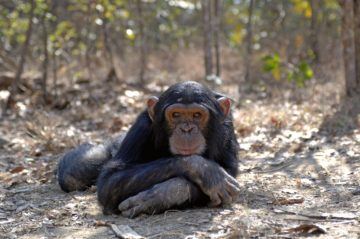Natalie Angier in The New York Times:
 Julia, her friends and family agreed, had style. When, out of the blue, the 18-year-old chimpanzee began inserting long, stiff blades of grass into one or both ears and then went about her day with her new statement accessories clearly visible to the world, the other chimpanzees at the Chimfunshi wildlife sanctuary in Zambia were dazzled.
Julia, her friends and family agreed, had style. When, out of the blue, the 18-year-old chimpanzee began inserting long, stiff blades of grass into one or both ears and then went about her day with her new statement accessories clearly visible to the world, the other chimpanzees at the Chimfunshi wildlife sanctuary in Zambia were dazzled.
Pretty soon, they were trying it, too: first her son, then her two closest female friends, then a male friend, out to eight of the 10 chimps in the group, all of them struggling, in front of Julia the Influencer — and hidden video cameras — to get the grass-in-the-ear routine just right. “It was quite funny to see,” said Edwin van Leeuwen of the University of Antwerp, who studies animal culture. “They tried again and again without success. They shivered through their whole bodies.”
Dr. van Leeuwen tried it himself and understood why.
“It’s not a pleasant feeling, poking a piece of grass far enough into the ear to stay there,” he said. But once the chimpanzees had mastered the technique, they repeated it often, proudly, almost ritualistically, fiddling with the inserted blades to make sure others were suitably impressed.
Julia died more than two years ago, yet her grassy-ear routine — a tradition that arose spontaneously, spread through social networks and skirts uncomfortably close to a human meme or fad — lives on among her followers in the sanctuary. The behavior is just one of many surprising examples of animal culture that researchers have lately divulged, as a vivid summary makes clear in a recent issue of Science. Culture was once considered the patented property of human beings: We have the art, science, music and online shopping; animals have the instinct, imprinting and hard-wired responses. But that dismissive attitude toward nonhuman minds turns out to be more deeply misguided with every new finding of animal wit or whimsy: Culture, as many biologists now understand it, is much bigger than we are.
More here.
